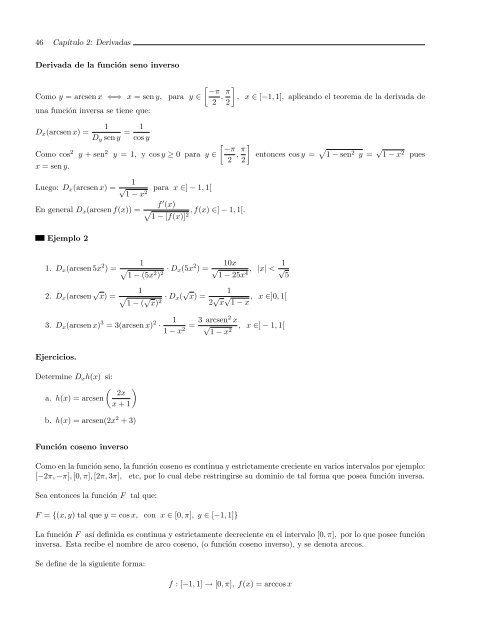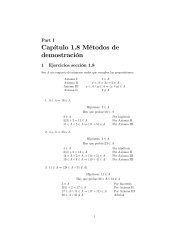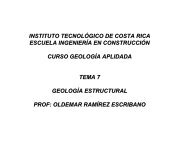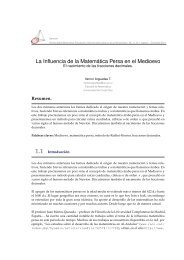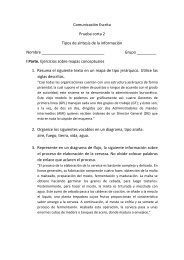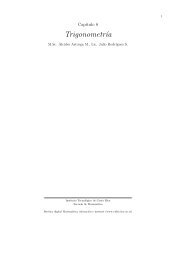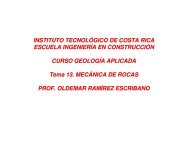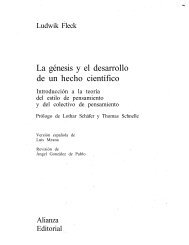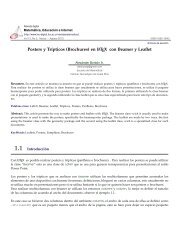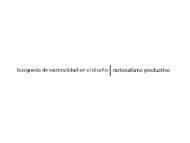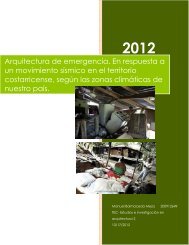Derivada de una función - TEC-Digital
Derivada de una función - TEC-Digital
Derivada de una función - TEC-Digital
Create successful ePaper yourself
Turn your PDF publications into a flip-book with our unique Google optimized e-Paper software.
46 Capítulo 2: <strong>Derivada</strong>s<br />
<strong>Derivada</strong> <strong>de</strong> la <strong>función</strong> seno inverso<br />
Como y = arcsen x ⇐⇒ x = sen y, para y ∈<br />
<strong>una</strong> <strong>función</strong> inversa se tiene que:<br />
1<br />
Dx(arcsen x) =<br />
Dy sen y<br />
= 1<br />
cos y<br />
Como cos 2 y + sen 2 y = 1, y cos y ≥ 0 para y ∈<br />
x = sen y.<br />
Luego: Dx(arcsen x) =<br />
1<br />
√ 1 − x 2<br />
En general Dx(arcsen f(x)) =<br />
Ejemplo 2<br />
1. Dx(arcsen 5x 2 ) =<br />
2. Dx(arcsen √ x) =<br />
3. Dx(arcsen x) 3 = 3(arcsen x) 2 ·<br />
Ejercicios.<br />
Determine Dxh(x) si:<br />
<br />
2x<br />
a. h(x) = arcsen<br />
x + 1<br />
b. h(x) = arcsen(2x 2 + 3)<br />
Función coseno inverso<br />
para x ∈] − 1, 1[<br />
<br />
−π π<br />
, , x ∈ [−1, 1], aplicando el teorema <strong>de</strong> la <strong>de</strong>rivada <strong>de</strong><br />
2 2<br />
<br />
−π π<br />
,<br />
2 2<br />
f ′ (x)<br />
, f(x) ∈] − 1, 1[.<br />
1 − [f(x)] 2<br />
1<br />
<br />
1 − (5x2 ) 2 · Dx(5x 2 10x<br />
1<br />
) = √ , |x| < √<br />
1 − 25x4 5<br />
1<br />
√<br />
1 − ( x) 2 · Dx( √ 1<br />
x) =<br />
2 √ x √ , x ∈]0, 1[<br />
1 − x<br />
1<br />
1 − x2 = 3 arcsen2 x<br />
√ , x ∈] − 1, 1[<br />
1 − x2 entonces cos y = 1 − sen 2 y = √ 1 − x 2 pues<br />
Como en la <strong>función</strong> seno, la <strong>función</strong> coseno es continua y estrictamente creciente en varios intervalos por ejemplo:<br />
[−2π, −π], [0, π], [2π, 3π], etc, por lo cual <strong>de</strong>be restringirse su dominio <strong>de</strong> tal forma que posea <strong>función</strong> inversa.<br />
Sea entonces la <strong>función</strong> F tal que:<br />
F = {(x, y) tal que y = cos x, con x ∈ [0, π], y ∈ [−1, 1]}<br />
La <strong>función</strong> F así <strong>de</strong>finida es continua y estrictamente <strong>de</strong>creciente en el intervalo [0, π], por lo que posee <strong>función</strong><br />
inversa. Esta recibe el nombre <strong>de</strong> arco coseno, (o <strong>función</strong> coseno inverso), y se <strong>de</strong>nota arccos.<br />
Se <strong>de</strong>fine <strong>de</strong> la siguiente forma:<br />
f : [−1, 1] → [0, π], f(x) = arccos x


